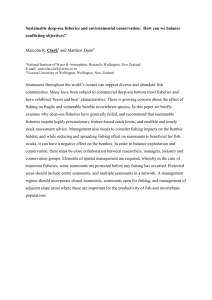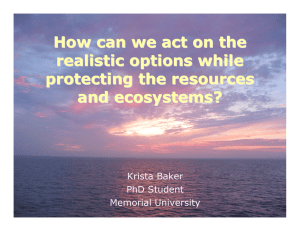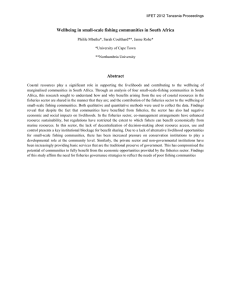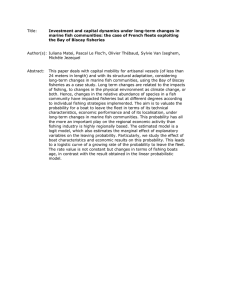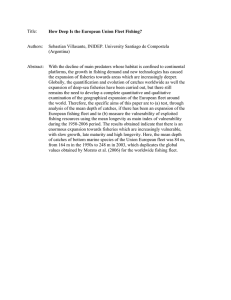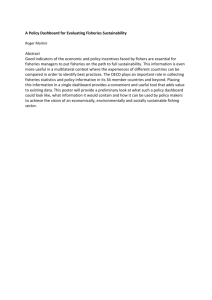How much longer will it take? - The Deep Sea Conservation Coalition
advertisement
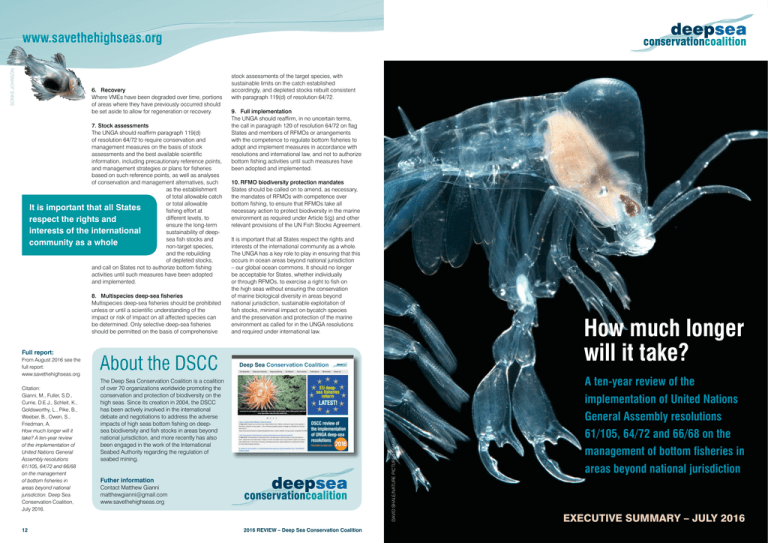
6.Recovery Where VMEs have been degraded over time, portions of areas where they have previously occurred should be set aside to allow for regeneration or recovery. 7. Stock assessments The UNGA should reaffirm paragraph 119(d) of resolution 64/72 to require conservation and management measures on the basis of stock assessments and the best available scientific information, including precautionary reference points, and management strategies or plans for fisheries based on such reference points, as well as analyses of conservation and management alternatives, such as the establishment of total allowable catch or total allowable It is important that all States fishing effort at different levels, to respect the rights and ensure the long-term interests of the international sustainability of deepsea fish stocks and community as a whole non-target species, and the rebuilding of depleted stocks, and call on States not to authorize bottom fishing activities until such measures have been adopted and implemented. 8. Multispecies deep-sea fisheries Multispecies deep-sea fisheries should be prohibited unless or until a scientific understanding of the impact or risk of impact on all affected species can be determined. Only selective deep-sea fisheries should be permitted on the basis of comprehensive Full report: From August 2016 see the full report: www.savethehighseas.org Citation: Gianni, M., Fuller, S.D., Currie, D.E.J., Schleit, K., Goldsworthy, L., Pike, B., Weeber, B., Owen, S., Friedman, A. How much longer will it take? A ten-year review of the implementation of United Nations General Assembly resolutions 61/105, 64/72 and 66/68 on the management of bottom fisheries in areas beyond national jurisdiction. Deep Sea Conservation Coalition, July 2016. 12 stock assessments of the target species, with sustainable limits on the catch established accordingly, and depleted stocks rebuilt consistent with paragraph 119(d) of resolution 64/72. 9. Full implementation The UNGA should reaffirm, in no uncertain terms, the call in paragraph 120 of resolution 64/72 on flag States and members of RFMOs or arrangements with the competence to regulate bottom fisheries to adopt and implement measures in accordance with resolutions and international law, and not to authorize bottom fishing activities until such measures have been adopted and implemented. 10.RFMO biodiversity protection mandates States should be called on to amend, as necessary, the mandates of RFMOs with competence over bottom fishing, to ensure that RFMOs take all necessary action to protect biodiversity in the marine environment as required under Article 5(g) and other relevant provisions of the UN Fish Stocks Agreement. It is important that all States respect the rights and interests of the international community as a whole. The UNGA has a key role to play in ensuring that this occurs in ocean areas beyond national jurisdiction – our global ocean commons. It should no longer be acceptable for States, whether individually or through RFMOs, to exercise a right to fish on the high seas without ensuring the conservation of marine biological diversity in areas beyond national jurisdiction, sustainable exploitation of fish stocks, minimal impact on bycatch species and the preservation and protection of the marine environment as called for in the UNGA resolutions and required under international law. How much longer will it take? About the DSCC The Deep Sea Conservation Coalition is a coalition of over 70 organizations worldwide promoting the conservation and protection of biodiversity on the high seas. Since its creation in 2004, the DSCC has been actively involved in the international debate and negotiations to address the adverse impacts of high seas bottom fishing on deepsea biodiversity and fish stocks in areas beyond national jurisdiction, and more recently has also been engaged in the work of the International Seabed Authority regarding the regulation of seabed mining. DAVID SHALE/NATURE PICTURE LIBRARY SONKE JOHNSON www.savethehighseas.org Futher information Contact Matthew Gianni matthewgianni@gmail.com www.savethehighseas.org 2016 REVIEW – Deep Sea Conservation Coalition A ten-year review of the implementation of United Nations General Assembly resolutions 61/105, 64/72 and 66/68 on the management of bottom fisheries in areas beyond national jurisdiction EXECUTIVE SUMMARY – JULY 2016 The United Nations General Assembly (UNGA) in 2002 adopted the first in a series of resolutions regarding the conservation of biodiversity in the deep sea. P rompted by serious concerns raised by scientists, non-governmental organizations (NGOs) and numerous States, these resolutions progressively committed States to act both individually and through regional fishery management organizations (RFMOs) to either manage bottom fisheries in areas beyond national jurisdiction to prevent significant adverse impacts on deep-sea species, ecosystems and biodiversity or else prohibit bottom fishing from taking place. It has now been almost 15 years since the debate over deep-sea bottom fisheries first began in the UNGA. Ten years have passed since the adoption of resolution 61/105 in 2006, calling on States to take a set of specific actions to manage bottom fisheries in areas beyond national jurisdiction to protect vulnerable marine ecosystems (VMEs) from the adverse impacts of bottom fishing and ensure the sustainability of deep-sea fish stocks. Despite the considerable progress by some RFMOs, there remain significant gaps in the implementation of key elements and commitments in the resolutions. This year, the UNGA will review progress toward the implementation of its resolutions and identify areas for improvement. SONKE JOHNSON Executive summary The Deep Sea Conservation Coalition (DSCC), together with its member organizations, has advocated for the application of the precautionary and ecosystem approach to the management of deep-sea fisheries since 2004. It has worked since 2006 to achieve the implementation of the UNGA’s resolutions at relevant RFMOs and through other regional negotiating processes, as well as in the national capitals of a number of high seas fishing States. Based on this experience, and supplemented by extensive research, the DSCC has prepared a report to assist the UNGA in its review in 2016 and to address the following question: How effectively have the resolutions been implemented? Key findings The report of the UNGA’s First Global Marine Assessment, published in 2015, states that the deep sea constitutes the largest source of species and ecosystem diversity on Earth. These ecosystems are crucial for global functioning and there is strong evidence that the richness and diversity of organisms in the deep sea exceed that in all other known biomes, from the metazoan to the microbial realms.1 At the same time, the documented extent of deepwater trawl fisheries has led to pervasive concern for the conservation of fragile benthic habitats associated with seamounts and other deep-sea environments.2 The report further states that the vast majority of deep-water fisheries have been carried out unsustainably, or at least without satisfactory assessments of impacts and sustainability. This has led both to the serial depletion of dozens of targeted stocks and to severe impacts reported for bycatch species, including other fishes and First Global Integrated Marine Assessment (First World Ocean Assessment) by the Group of Experts of the Regular Process under the auspices of the United Nations General Assembly and its Regular Process for Global Reporting and Assessment of the State of the Marine Environment, including Socioeconomic Aspects. United Nations General Assembly. Chapter 36F. Open Ocean Deep Sea. Page 1. http://www.un.org/depts/ los/global_reporting/WOA_ RPROC/Chapter_36F.pdf 2 ibid. Chapter 51. Biological Communities on Seamounts and Other Submarine Features Potentially Threatened by Disturbance. Page 9. SONKE JOHNSON 1 2 2016 REVIEW – Deep Sea Conservation Coalition ibid. Chapter 51. Biological Communities on Seamounts and other Submarine Features Potentially Threatened by Disturbance. Page 16. 4 Pusceddu et al. (2014). Chronic and intensive bottom trawling impairs deep-sea biodiversity and ecosystem functioning. Proceedings of the National Academy of Sciences of the United States. http://www.pnas.org/content/ early/2014/05/14/1405454111. full.pdf+html?sid=3bf67eb590d3-4b3b-b3b5d151a358cde9 5 Trueman et al. (2014). Trophic interactions of fish communities at midwater depths enhance long-term carbon storage and benthic production on continental slopes. Proc. R. Soc. B 281: 20140669. http://dx.doi. org/10.1098/rspb.2014.0669 6 Gianni, M. (2004). High Seas Bottom Trawl Fisheries and their Impacts on the Biodiversity of Vulnerable Deep-Sea Ecosystems: Options for International Action. IUCN, Gland, Switzerland. 3 benthic invertebrates from diverse coral and sponge communities. The report concludes that although the impacts have not been assessed globally, extrapolations from local and regional studies indicate that deep-sea fishing – and in particular deep-water trawling – has likely caused severe, widespread, long-term destruction of deep-sea environments globally.3 The conclusions of the Global Marine Assessment mirror those of a study published in 2014 which looked at the impact of bottom trawling on deep-sea sediment areas in the Mediterranean and concluded that “intensive and chronic bottom trawling is deemed to transform large portions of the deep continental slope into faunal deserts and highly degraded seascapes” and that bottom trawling “represents a major threat to the deep seafloor ecosystem at the global scale”.4 The adverse impacts of deep-sea bottom fishing are not confined to the degradation or destruction of VMEs. Another study published in 2014 looked at the feeding habits of bottom dwelling fish inhabiting depths between 500–1800 meters along the Irish and UK continental slopes and estimated that this community of fish alone captures and stores a volume of carbon equivalent to over 1 million tonnes of CO2 every year.5 The UNGA first expressed concern over the threats to the biodiversity of seamounts and other deep-sea areas beyond national jurisdiction in resolution 57/141, adopted in 2002. At that time, virtually no management measures were in place to protect deep-sea benthic ecosystems in these areas from the harmful impacts of bottom fishing, in particular bottom trawling. Moreover, there were few RFMOs with the legal competence to manage bottom fisheries on the high seas. In the North Pacific, South Pacific, Southwest Atlantic and Indian Oceans, there were no RFMOs or arrangements of any kind to manage high seas bottom fisheries, although substantial bottom fisheries were occurring in each region. Where competent RFMOs did exist, high seas bottom fisheries in these areas were unregulated insofar as impacts on the marine environment were concerned.6 Beginning in 2004, UNGA resolutions 59/25 (2004), 61/105 (2006), 64/72 (2009), and 66/68 (2011) called for urgent action to protect VMEs from the harmful impact of destructive bottom fishing practices. They committed States and RFMOs to i) conduct impact assessments of individual bottom fisheries and cumulative impacts of bottom fishing, ii) close areas where VMEs are known or likely to occur to bottom fishing unless the fishing can be managed to prevent significant adverse impacts on VMEs, and iii) ensure sustainable levels of catch and bycatch of deep-sea species, including the rebuilding of depleted stocks, or else not authorize bottom fisheries to proceed. As a result of the adoption of the UNGA resolutions, there have been significant improvements in the management of deep-sea fisheries in areas beyond national jurisdiction. Far more information on the impact of deep-sea fishing is now available in most high seas regions as a result of 2016 REVIEW – Deep Sea Conservation Coalition the efforts of States and RFMOs to implement these resolutions. This includes information on the known or likely occurrence of VMEs, the impact of various gear types on VMEs, and the catch and bycatch of fish species in deep-sea fisheries. The information has been derived from several sources: i) scientific research prompted by the UNGA resolutions, such as the multinational Nereida, Ecovul-arpa, Atlantis and Rap-Sur expeditions led by the Spanish Institute of Oceanography and other national and multinational programs led by Norway, Japan, Canada, New Zealand and others; ii) independent scientific initiatives; iii) observer programs onboard many high seas bottom fishing vessels; iv) catch reporting requirements; and v) other informationgathering measures adopted by RFMOs in response to the UNGA resolutions. In regard to the management of deep-sea bottom fisheries, important achievements since the adoption of the UNGA resolutions include: 1. Three new agreements establishing that RFMOs are to manage high seas bottom fisheries in the North Pacific, South Pacific and Southern Indian Ocean have been negotiated and entered into force. 2. The North East Atlantic Fisheries Commission (NEAFC), the Northwest Atlantic Fisheries Organization (NAFO) and the South East Atlantic Fisheries Organisation (SEAFO) have closed substantial areas of the high seas at fishable depths to bottom fishing, including a number of areas where VMEs are known to occur. NEAFC and SEAFO have further closed large “representative” areas where VMEs are likely to occur (see the maps on pages 5–8). 3. Measures adopted by the States involved in negotiating the new North Pacific Fisheries Commission (NPFC) and the regulations adopted by the South Pacific RFMO (SPRFMO) restrict bottom fishing on the high seas in these regions to a historic fisheries footprint unless a prior impact assessment is conducted to allow vessels to bottom fish outside of the footprint. 4. Bottom trawling has been prohibited by the Commission for the Conservation of Antarctic Marine Living Resources (CCAMLR) on the high seas in the Southern Ocean. The General Fisheries Commission for the Mediterranean (GCFM) has prohibited bottom trawling below 1000m. 5. Several RFMOs – CCAMLR, SPRFMO and NEAFC (the latter for areas below 200m) – have established bans on the use of bottom gillnets in their regulatory areas. SEAFO has a standing “recommendation” (since 2009) that gillnets be banned in the SEAFO Convention Area until more information becomes available. 6. Most RFMOs and States involved in regional negotiating processes to establish new RFMOs to manage bottom fisheries in the high seas have adopted (although not fully implemented) binding regulations or multilateral “interim measures” to manage bottom fisheries largely consistent with the UNGA resolutions. In most cases the regulations have incorporated key provisions of the International 3 Guidelines for the Management of Deep-Sea Fisheries in the High Seas (UN FAO Guidelines). These establish internationally agreed criteria for identifying VMEs, conducting impact assessments and determining significant adverse impacts of bottom fisheries (see Table 1). 7. In areas of the high seas where no RFMO exists or is under negotiation, the European Union (EU) has adopted and implemented measures pursuant to paragraph 85 of resolution 61/105 with respect to vessels flying the flag of EU member states. As a result, Spain conducted a comprehensive impact assessment of the potential impact of bottom fishing on VMEs on the high seas in the Southwest Atlantic and closed most of the area below 400m to Spanish trawlers to protect VMEs. 8. Transparency in the work of the RFMOs managing bottom fisheries in the high seas has improved considerably over the past decade, both for the already established RFMOs such as NEAFC and NAFO as well as the new RFMOs in the North and South Pacific and Indian Oceans. However, many of the commitments in the UNGA resolutions – in particular the specific actions called for in the resolutions beginning with resolution 61/105 – remain either partially or entirely unfulfilled, leaving vast areas of ocean unprotected. Regional shortcomings The regional sections of the full DSCC report highlight specific shortcomings in each region, which are summarized as follows: KEY Y = Yes; N = NO; VMEs = vulnerable marine ecosystems; IAs = impact assessments; SAIs = significant adverse impact a NAFO and NEAFC have both assessed a number of areas within the fisheries footprint for the presence or likely occurrence of VMEs b SPRFMO – Incorporated into SPRFMO Benthic Fishery Impact Assessment Standard c CCAMLR measures are largely equivalent to those found in the FAO Guidelines d Measures to take effect beginning in 2018 e Under the SIOFA regulation adopted in July 2016, impact assessments are required to “be prepared, to the extent possible, in accordance with the FAO Deepsea Fisheries Guidelines” (CMM 2016/01, paragraph 18(a)) f Adopted in July 2008, prior to completion of the FAO Guidelines but contains definitions and provisions similar to those in the Guidelines. 4 Inadequate assessments Many of the impact assessments that have been carried out for bottom fisheries in the high seas are not consistent with the criteria established in the UN FAO Guidelines and endorsed by the UNGA beginning with resolution 64/72. The impact assessments are often partial or inconclusive, or both, as a result of a lack of good baseline information, substantial scientific uncertainties and/or other reasons. Open, closed and other areas at fishable depths per region No cumulative assessments Cumulative impact assessments as called for in resolution 66/68 have not been conducted in any region. This includes in relation to the current status of VMEs that were impacted or degraded by bottom fishing in the years prior to the adoption of the UNGA resolutions. KEY – Estimate of Fishable Depth by RFMO/Region VME areas remain open to bottom fishing Some high seas areas have been closed to bottom fishing, but many areas where VMEs are likely to occur remain open to bottom fishing without having been properly assessed. Moreover, there has been a general reluctance on the part of a number of States and RFMOs to close areas identified as VMEs where bottom fishing currently takes place, or has taken place in recent years. In some cases, bottom trawl fisheries occurring in VMEs identified by scientific bodies have been neither assessed nor prohibited. This is true, for example, for several VMEs in the NAFO and NEAFC areas. No areas have been formally closed to bottom fishing by the South Pacific or Indian Ocean RFMOs although some of the individual flag States in these regions have closed some areas to their fleets (e.g. New Zealand in the South Pacific). RFMO Name NAFO Northwest Atlantic Fisheries Organization 2000m NEAFC North East Atlantic Fisheries Commission 1500m GFCM General Fisheries Commission for the Mediterranean 1500m SEAFO South East Atlantic Fisheries Organisation 2000m NPFC North Pacific Fisheries Commission 1500m 1500m SIOFA 1500m South Indian Ocean Fisheries Agreement 2000m Isobath VME/Bottom fishery closure Existing bottom fishery Regulatory Area “Fishable” Depth SPRFMO South Pacific Regional Fisheries Management Organization CCAMLR Commission for the Conservation of Antarctic Marine Living Resources NAFO Seamounts <2000m deep 2200m For a detailed description of the methods and analysis used to produce the maps see Section 1.1 “Methods and Analysis” of the full DSCC report NEAFC NAFO Overlarge footprints Fishing “footprints” are the areas that have been delineated by a number of States and RFMOs to allow bottom fishing to continue based on “historical” bottom fishing in the region. In some cases these are very large and include half or more of the entire area of the seabed at various fishable depths (e.g. South Pacific, Northwest Atlantic). Continues on page 9 V % “Fishable” % “Fishable” Area Seamounts Areas closed to all bottom fishing 12.9% 57.6% Areas where bottom fishing is permitted 79.0% 0.0% Areas where prior impact assessment required before bottom fishing can occur 8.1% 42.4% TOTAL 140,368 33 km2 seamounts Table 1. Extent to which key provisions of the UNGA resolutions and FAO Guidelines have been incorporated into interim measures and/or binding regulations adopted by RFMOs and regional negotiating processes NEAFC Area/region Areas closed to all bottom fishing 16.7% 33.1% Areas where bottom fishing is permitted 37.3% 8.6% Areas where prior impact assessment required before bottom fishing can occur 46.0% 58.3% Require Impact Assessments Incorporated the criteria in the FAO International Guidelines for the Management of Deep-Sea Fisheries in the High Seas for identifying VMEs, conducting impact assessments and determining SAIs into RFMO regulations Inside Outside SAIs (paras footprint footprint 17–20) VMEs (para 42) IAs (para 47) requirement to assess impact on ‘low productivity fish’ as well as VMEs NAFO a By 2016 Y Y Y Y N NEAFC a N Y Y Y Y N SEAFO N Y Y Y Y N SPRFMO Y Y Y Yb Y N GFCM N N N N N N Yc Yc Yc % “Fishable” % “Fishable” Area Seamounts TOTAL 300,646 139 km2 seamounts Seamounts <1500m deep CCAMLR Y Y Yc NPFC Y Y Y Y Y Y SIOFA d Y N Y Ye VME/Bottom fishery closure Y N EU: SW Atlantic/ Non RFMO Areas f Existing bottom fishery Y Y Y Y Y N Regulatory Area 2016 REVIEW – Deep Sea Conservation Coalition 1500m Isobath 2016 REVIEW – Deep Sea Conservation Coalition 5 NPFC GFCM GFCM % “Fishable” % “Fishable” Area Seamounts Areas closed to bottom trawling (incl 3 VME areas in red) 18.1% 39.7% Areas where bottom fishing is permitted 81.9% 60.3% TOTAL 1,496,929 136 km2 seamounts NPFC % “Fishable” % “Fishable” Area Seamounts Areas closed to all bottom fishing 0.5% 0.3% Areas where bottom fishing is permitted 38.9% 12.1% TOTAL 49,823 398 km2 seamounts Seamounts <1500m deep 1500m Isobath Seamounts <1500m deep VME/Bottom fishery closure 1500m Isobath Existing bottom fishery VME Bottom fishery closure Regulatory Area SPRFMO* SEAFO SEAFO % “Fishable” % “Fishable” Area Seamounts Areas closed to bottom trawling 5.1% 1.8% Areas closed to all bottom fishing including bottom trawling 16.1% 21.5% Areas where bottom fishing is permitted 42.9% 25.5% Areas where prior impact assessment required before bottom fishing can occur 41.0% 53.0% 175,943 502 km2 seamounts TOTAL % “Fishable” Area % “Fishable” Seamounts Areas closed to all bottom fishing 0.0% 0.0% Areas closed to bottom trawl by New Zealand 15.6% 3.3% Areas closed to bottom fishing by Australia 0.0% 0.0% Areas where bottom fishing is permitted by New Zealand 7.5% 3.1% Areas where bottom fishing is permitted by Australia 14.9% 3.1% Areas where prior impact assessment required before bottom fishing can occur for New Zealand vessels 76.9% 93.6% Areas where prior impact assessment required before bottom fishing can occur for Australian vessels 85.1% 96.9% TOTAL Seamounts <2000m deep 2000m Isobath 371,117 880 km2 seamounts SPRFMO * The estimate in this table of the percentage of the area at fishable depths open to bottom fishing by New Zealand is considerably lower than that of Penny et al as indicated in Section 5.2.2 of the full DSCC report. They estimate that approximately 16% of the SPRFMO area at depths shallower than 2,000m is located within the open (green) areas of the New Zealand bottom fisheries footprint. Bottom trawl closure Existing bottom fishery – open to all bottom gear 6 Seamounts <1500m deep 1500m Isobath Existing bottom fishery – closed to bottom trawl (pots and/or longlines only) VME/Bottom fishery closure Regulatory Area Regulatory Area 2016 REVIEW – Deep Sea Conservation Coalition Existing bottom fishery 2016 REVIEW – Deep Sea Conservation Coalition 7 C Continues on page 4 SIOFA SIOFA % “Fishable” % “Fishable” Area Seamounts Areas closed to all bottom fishing 0.0% 0.0% Areas voluntarily closed to bottom fishing by SIODFA* vessels 6.9% 6.3% Areas where bottom fishing is permitted by Australia 19.8% 36.0% 205,260 253 km seamounts TOTAL 2 * South Indian Ocean Deepwater Fishers’ Association Seamounts <1500m deep 1500m Isobath Voluntary bottom fishery closure Regulatory Area http://cmsdata.iucn.org/ downloads/iucn_european_ red_list_of_marine_fishes_ web_1.pdf 7 Widespread bottom trawling Deep-sea bottom trawling continues to be the most pervasive form of bottom fishing on the high seas. This is despite concerns repeatedly highlighted in scientific studies and assessments over the past ten years regarding the destructive impact of bottom trawling on deep-sea species, ecosystems, biodiversity and, more recently, the capacity of deepsea species and sediment ecosystems to capture and sequester carbon. Insufficient move-on rules “Move-on” rules require fishers to cease fishing when they encounter a VME. They are often the only conservation measure in place to protect VMEs in areas where bottom fishing is permitted (so-called “open” or “existing” bottom fishing areas generally corresponding to an historical bottom fisheries footprint). Yet these rules are of limited value given the high threshold levels required to trigger cessation of fishing and movement from the area and the reliance on skippers to report the encounter. Even under the best case scenario, the move-on rules established by most RFMOs are not likely to prevent continued damage to VMEs from bottom trawl fishing because significant damage will likely have already occurred as a result of an “encounter”. Outside the CCAMLR area few (if any) areas have been closed as a result of the move-on rule over the past ten years. EU/SPANISH BOTTOM FISHERY SOUTHWEST ATLANTIC CCAMLR Lack of information on status of stocks For most deep-sea species there is insufficient information to determine the status of the stocks or the impact of fishing on the species (in particular bycatch species), although most are recognized as or are likely to be slow-growing, long-lived, low-fecundity species particularly vulnerable to overexploitation. In the North Pacific, for example, the stock of the main target species in the deep-sea fisheries is assessed based on a “depletion analysis” which essentially is an after-the-fact assessment of the status of the stock to determine how much it has been depleted by fishing in a given year. 100.0% 100.0% Areas closed to all bottom fishing 0.7% 2.4% Areas where bottom fishing is permitted 99.3% 97.6% TOTAL Flag States Most flag States whose vessels engaged in bottom fisheries on the high seas in the years leading up to the adoption of resolution 61/105 in 2006 continue to authorize vessels to bottom fish on the high seas today. The majority of vessels currently authorized to bottom fish on the high seas are flagged to a relatively small number of States, including several EU member states (e.g. Spain and Portugal); New Zealand; Japan; Russian Federation; Republic of Korea; Australia; and the Cook Islands. % “Fishable” % “Fishable” Area Seamounts Areas closed to bottom trawling MAPS: BETH PIKE, MARINE-CONSERVATION.ORG Unregulated catch in deep-sea fisheries Information provided by observer programs and other sources indicates that hundreds of species are caught as either target or bycatch species in bottom fisheries on the high seas. Yet only a few dozen species are subject to quotas or catch limits. Quotas have been established by SEAFO, NAFO and NEAFC for a number of the target species taken in deep-sea fisheries. However, in the South Pacific for example, over 130 species have been reported caught in the high seas bottom fisheries. Yet there are no restrictions on the catch of any species other than a general measure adopted by SPRFMO to limit each Contracting Party to a level of “bottom fishing catch” that does not exceed its annual average level between 2002 and 2006. Endangered species A number of deep-sea species in the Northeast Atlantic have been classified by the IUCN as vulnerable, endangered or critically endangered. These include three of the main species targeted in deep-sea fisheries in the region – orange roughy, roundnose grenadier and blue ling – as well as several species of deep-sea sharks taken as bycatch in deep-sea fisheries.7 CCAMLR 5,302,522 1,047 km2 seamounts Numbers of vessels The numbers of vessels engaged in bottom fisheries and/or the volume of catch in deep-sea fisheries on the high seas has varied considerably over the past 15 years in at least two ocean regions (Northwest Atlantic and Southern Indian Ocean). But in general it appears that the number of such vessels has declined somewhat over the past few Seamounts <2200m deep 2200m Isobath VME/Bottom fishery closure Regulatory Area 8 Overfished stocks Many deep-sea species for which stock assessments have been conducted and/or quotas have been established are considered overexploited or depleted. 2016 REVIEW – Deep Sea Conservation Coalition 2016 REVIEW – Deep Sea Conservation Coalition 9 Gianni, above, note 6. Bensch, A., Gianni, M., Gréboval, D., Sanders, J.S., Hjort, A. (2009). Worldwide review of bottom fisheries in the high seas. FAO Fisheries and Aquaculture Technical Paper. No. 522, Rev.1. Rome, FAO. 145pp. 8 NOAA http://oceanexplorer.noaa.gov/backmatter/faqs.html 9 10 As indicated, the extent to which the UNGA resolutions have been implemented varies widely by region. CCAMLR, for example, has adopted and implemented measures consistent with the resolutions that require comprehensive impact assessments for high seas bottom fisheries in the Southern Ocean and prohibits bottom trawling in all high seas areas. It has also established measures to limit the bycatch of a number of deep-sea species, implemented a comprehensive scientific observer program, and continues to conduct scientific research into the impact of bottom longline fishing on VMEs. By contrast, multilateral implementation of the resolutions in the Southern Indian Ocean has been non-existent. Although some flag States have adopted unilateral measures, no regional measures have been adopted despite continued high seas bottom fishing in the region over the past ten years. While the RFMO responsible, SIOFA, has had two meetings of the Contracting Parties since the entry into force of the SIOFA convention in 2012, it has adopted no interim or actual measures to regulate bottom trawling. Even a proposal for a ban on bottom gillnet fishing put forward at the last meeting of the Contracting Parties was not adopted. In the Southwest Atlantic – a region of extensive high seas bottom fishing but where no RFMO exists or is under negotiation – the UNGA called on flag States to unilaterally implement the provisions of the resolutions. Here flag State practice has varied widely. Management measures consistent with the resolutions have been implemented by the EU and Spain for Spanish fleets operating on the high seas in the region. These include area closures to protect VMEs on the basis of an extensive impact assessment conducted by the Spanish Institute of Oceanography. However, as far as the DSCC is aware, none of the other flag States whose vessels bottom fish in the region have implemented similar measures. Conclusions and recommendations UNGA Resolutions 61/105, 64/72, and 66/68 are the products of extensive negotiation and review by the UNGA over the past ten years. They express the will and commitment of the international community of nations to ensure effective management of deep-sea fisheries in the context of the ecosystem approach and precautionary approach. Moreover, they have important implications for the conservation of biodiversity and the protection and preservation of the marine environment in areas beyond national jurisdiction. As such, the specific actions called for in the resolutions regarding managing deep-sea fisheries to prevent significant adverse impacts on VMEs and the sustainable exploitation of fish stocks reflect important obligations in Articles 5 and 6 of the 1995 UN Fish Stocks Agreement and in Part XII of the Law of the Sea Convention. While important progress has been made to implement the provisions of the UNGA resolutions, there are numerous shortcomings. These shortcomings are not trivial. The UNGA placed increasing emphasis in 2009 and again in 2011 on the need to conduct prior impact assessments or else ensure that such fisheries are not authorized to occur. The international community expended considerable effort in negotiating internationally agreed standards and criteria for conducting such assessments as reflected in the UN FAO Guidelines. However, there are numerous instances where RFMOs have allowed areas to remain open to bottom fishing where VMEs are known or likely to occur, without having assessed the bottom fisheries in these areas to determine whether significant adverse impacts would occur. In some cases, within the areas where bottom fishing is permitted, VMEs identified by scientific bodies have not been closed, or have only partially been closed, to avoid restricting fishing in the area rather than preventing significant adverse impacts on VMEs. This is the fundamental opposite of what the UNGA resolutions have called for and committed high seas bottom fishing States to do. On the question of the sustainable exploitation of fish stocks – arguably the core business of RFMOs – there are serious shortcomings as well. In the North Pacific, South Pacific and Indian Oceans, stock assessments have not been conducted for most, if not all, target species and thus sustainability cannot be ensured. In most ocean regions, the number of species taken as bycatch is high and many (if not most) are likely to be slow growing, long lived, and vulnerable to even limited exploitation. Yet very little is known about the status of most of the stocks of these deep-sea bycatch species (or even how many 2016 REVIEW – Deep Sea Conservation Coalition NOAA http://oceanexplorer.noaa.gov/backmatter/faqs.html years compared to the estimated numbers of vessels involved in high seas bottom fishing in the years 2001 (IUCN)8 and 2006 (UN FAO)9. In several regions the number of vessels authorized to fish is considerably higher than the number that has actually engaged in bottom fishing in recent years. The DSCC recommendations in 2016 can be summarized as follows: distinct stocks there may be) or the impact of fishing mortality. In some cases, regulators may assume that the impact is low because the volume of bycatch of some or all species is relatively low. But these are assumptions only and in the case of the most vulnerable deep-sea species, such as deep-sea sharks, even limited fishing mortality may well be having a significant adverse impact, whether these species are targeted (as in the deep-sea gillnet and longline fisheries in the Indian Ocean) or taken as bycatch. More generally, the very limited scientific information on the life-history characteristics of most deep-sea species, and the even lesser understanding of food-web and trophic interactions of communities of deep-sea species (which themselves may qualify as VMEs), call into question whether it is even possible in the near term to “sustainably” manage non-selective or multispecies deep-sea fisheries. The questions for the UNGA review this year are what more needs to be done and how much longer will it, or should it, take to fully implement the resolutions? In 2004, the DSCC called for a moratorium on bottom trawl fishing on the high seas unless or until these fisheries are managed consistently with international law. The UNGA essentially agreed in 2006 – extending the call to include all bottom fisheries – by committing States and RFMOs to adopt and implement the specific set of measures contained in resolution 61/105 paragraph 83, by December 2008, and ensuring that bottom fishing does not proceed after that date “unless conservation and management measures have been established to prevent significant adverse impacts on vulnerable marine ecosystems”. This was reaffirmed in resolution 64/72 adopted in 2009 in which the UNGA committed States “not to authorize bottom fishing activities” until the measures in resolutions 61/105 and 64/72 have been “adopted and implemented”. The questions for the UNGA review this year are what more needs to be done and how much longer will it, or should it, take to fully implement the resolutions? 2016 REVIEW – Deep Sea Conservation Coalition 1. Impact assessments Comprehensive impact assessments, consistent with the UN FAO Guidelines, should be done in all areas where bottom fisheries are permitted or authorized to occur in areas beyond national jurisdiction. This would include: collecting sufficient baseline information on the ecosystems, habitats and communities in the fishing area against which future changes are to be compared; the identification, description, and mapping of VMEs known or likely to occur in the fishing area; and assessing the impact of fishing mortality on “low-productivity” fish species among other things, as called for in paragraph 47 of the UN FAO Guidelines. Low or non-impact technology and methods are available and should be used to map VME areas. High impact technology, in particular bottom trawl gear (whether used in research trawl surveys or commercial “exploratory” bottom fisheries), should be avoided or prohibited in such surveys. 2. Area closures All areas where VMEs are known or likely to occur, particularly within established bottom fisheries “footprints”, should be closed unless bottom fishing in these areas is assessed prior to authorizing bottom fishing and a scientifically based determination is made that significant adverse impacts will not, or are not likely to, occur. 3. Significant adverse impacts In determining whether significant adverse impacts may occur, impacts on slope sediment ecosystems also should be assessed. This includes in relation to impacts on infaunal biodiversity and the capacity of these ecosystems to act as carbon sinks. 4. VME criteria and the ecological role of VME species VMEs must be defined on the basis of the full suite of criteria outlined in the UN FAO Guidelines, not only on the basis of one (e.g. significant concentrations of VME indicator species only) or a few of the criteria in paragraph 42 of the Guidelines. Communities of deep-sea fish species should also be considered VMEs where they fit the criteria in the FAO Guidelines. A better understanding of the role or ecosystem function of VME species at appropriate bioregional scales is essential for determining the temporal, spatial and ecological extent of impacts and their significance as per the criteria in paragraphs 17–20 of the FAO Guidelines. 5. Cumulative impact assessments Cumulative impact assessments should be conducted in order to, among other things, determine the extent to which existing VMEs have been impacted over time by bottom fishing (e.g. are they remnant populations of VMEs only?) and/or are under threat from other stressors such as ocean acidification. They should be protected accordingly. Continues on page 12 V 11
